 Virtuosity and Performance
Mastery issue, 2003/04
Virtuosity and Performance
Mastery issue, 2003/04
Sketches of Motion: Kim Brandstrup with dancer Jonathan Poole (Arc Dance Company) and in conversation with Susan Melrose and Renate Bräuninger
Copyright © the participants 2003.
(No part of this text may be reproduced without the written permission of the authors.)
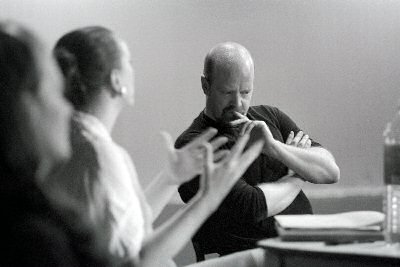
This material was presented live at the Virtuosity and Performance Mastery symposium for postgraduate/research degree students and academic staff over two days by Performing Arts at Middlesex University on 31st May and 1st June 2003.
Renate: What I am always reminded of when I see your Hamlet is a silent movie. I wanted to start by noting one or two things: the first is that your background was in films, hence the presence of story or narrative, and the second is that you set up certain frameworks of space and time in which certain things can take place.
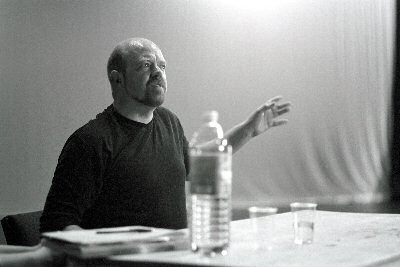
Kim: I like the notion of the silent movie very much and that was a kind of inspiration - and I think that that kind of stylization has always been in place. I think that certain bits like this were inspired by certain kinds of Russian physicalised theatre like Meyerhold for example and I think that film does of course inform what I do, although I'm not sure that it's in any conscious way...it comes out of the way I see... I think what I do in the construction of things is I do work with a story board, I do have very clear pictures of where I want people to arrive, so that comes from my filmic background, and I'm sure that the visual side - the decor and the lighting - is always preconceived. Having said all that, that's not really what choreography is about.
Renate: How did that change when you made the decision to go with dance instead of pursuing your original start in film - did the way you imagine visual images change?
Kim: What I was about to say about what is important about choreography is that the images may well be what everybody remembers two weeks after the show, but what I think has actually affected us when we watch is the time it took for a particular image to appear, and that is what choreography is about and of course this is what is very different from making films. Of course it's the length of the shot that determines how you perceive a film, but I think that in choreography, everything is about a preparation for arriving at a particular form, and this is what choreography for me is about. I think in film you can cut into the continuum and you can go different places and it doesn't disturb your sense of the continuum. I think what you have to make very clear in dance is where does one look - not where do the dancers go, but the motion of the particular situation, the whole group of dancers, where do they go, what kind of quality is there underneath.
So that's the editing that takes place in choreography. I think it's interesting, what Susan was saying earlier, I mean, it's difficult for me to come in as a practitioner and try to demonstrate virtuosity - as though somebody could give you a copy of something that's virtuosic - but what I really wanted to talk about is process. I thought that the way that what I'm going to talk about might enlighten this notion of virtuosity, is that in a lot of the examples we've heard - for example the coloratura - virtuosity is all of the movement before you arrive at the final note. What I think is that what is the magic, intangible moment that we deal with - it's the upbeat - (draws a sharp breath) - it's all the movement and the flurry before (pause) - and then we get there (spoken in a rush)!
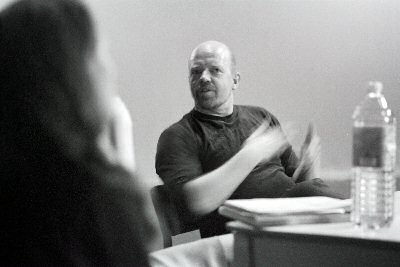
Renate: So there are moments in your choreography at which you're planning to let the movement go?
Kim: Yes, I set out parameters, I set out edit points or arrival points, a kind of - that is what constitutes the image, but the real job is to work out the motion or the flow or ...
Renate: what is it that characterizes those high points or those particular points you want to be reached?
Kim: In a way it's punctuation - it's like, somebody's on their way and then they arrive, and because of the way they arrive, we realise what it was about. The way I work is that it is always in retrospect that the meaning appears - you will never know in advance. In old-fashioned ballet it would appear, in the upbeat, you would in a way reveal it too soon, whereas I think it is much more real to go for it, and then you realise - that's where he was going.
Renate: So all of these points of arrival, they come up in rehearsal? I mean, you don't have them in advance?
Kim: Some of the images I have in advance, yes, those are there...
Renate: And how do they inform the path to get to them?
Kim: In a way the images, the arrival points, are the least important - I have them as a kind of structure but the real work is the movement, when I go into the studio with the dancers. So in a funny way, I never show the storyboard to the dancers, not at all, I put that as a kind of backup for me, that I can fall back on, and then I work totally in terms of movement and dynamics.
Susan: Can you talk a little bit about the music composed for the piece and its relationship to those decision-making processes?
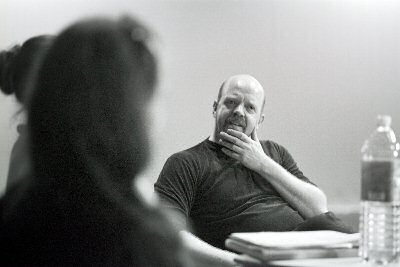
Kim: Again it's the same - what I do with the dancers is that I create units of time for their movement, I mean, I have the structure very clearly defined in terms of time; so I would have very clear durations - a nine or a three or a two, as you will see with Jonathan - and within those rooms of time, there's an enormous amount of freedom, both for the composer and for the dancer. But with the composer , Ian Beardon, who worked with me ten years ago on the first version of Hamlet - we worked very closely together. I give some outlines, in terms of pulse and in terms of timing, he may make a sketch, and I take it away, take it into the studio, to see what happens...
Susan: My sense here is that I'm recognizing a research process in the terms I was setting out this morning, that is, a research or epistemic practice in the sense that we would use the term in the university, but what is different is the language - and we need the language in the university, which de Certeau described in terms of the scriptural economy, but I would come back to the point I made earlier with regard to the use of metaphor in the second part of Nick Till's presentation this morning, which is that - to the extent that I'm familiar with dance writing - whether some of us can hold back from what I'd call the spectator's impulse to produce interpretative metaphor when we're looking at something which is too detailed and fine to be described in its actual detail. Whether we can hold back on the impulse to bring evaluation into that metaphoric account, which already means, if we do so, that I at least start to find it very difficult to pick back through these accretions, to identify the research processes which went into it. Which are actually Kim's compositional processes, which emerge from his own ongoing research through practice and reflection into choreographic decision-making processes. Whereas the choreographic decision-making processes, and the creative and professional imperatives which drive these - plus their relation to his ongoing research enquiry - is an area which is actually under-rehearsed in research in the university: that is, decision-making processes in the creative/professional realm.
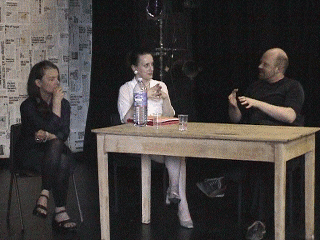
When I talked about multi-dimensional schematics this morning, I suppose that what I meant if I were to apply this to Kim's process is the sense I have that in the rehearsal room (and outside it) he is juggling with a whole range of processes to different ends - with the work of independent practitioners, both in terms of music and design as well as highly experienced dance - and that his decision-making in all of these instances has to meet professional criteria - which also means to reach something beyond the expected, because otherwise the work would fail in terms of creative and professional imperatives. This isn't an experimental practice in late 20th century terms; it isn't 'cutting edge', it isn't 'self-marginalising' or supposedly 'subversive of dominant forms'; it isn't a practice which is characterized by 'the right to fail', which many of us explored, again in the university, a decade or so back. It doesn't have the right to fail, because if it fails the professional future of the practitioners involved is at stake.
Kim: Of course, when you do Hamlet, then you do Hamlet, but it's a kind of reference point. The meaning-making is a matter of identifying particular moments in the piece, but the piece is made up of movement. When you talk about my decision-making processes, it's like controlling vapours. Movement is not the shape, movement is not 'the body'. Movement is something that comes through the body, which is in a way just a vehicle...
Susan: Except that you can choose 'bodies' that will be appropriate and challenging vehicles, so let's not have any of that nonsense where one talks about a professional dancer as though she were 'a body' or 'the body', because what's at stake here in terms of virtuosity is the fact that your starting-point in terms of application is a highly-trained, disciplinary 'body' - technical mastery, at the very least...
Kim: Yes, but it is technical mastery of movement, not of 'the body', and I think that that distinction is an important one.
Renate: But each of your dancers would have particular qualities of movement?
Kim: Absolutely.
Renate: And you choose your dancers on the basis of her or his particular qualities?
Kim: Absolutely, but each one of those dancers is in pursuit of motion, and not of expressing their bodies, and it's that pursuit of motion as apart from their bodies and themselves that makes them so expressive...
Renate: Is this just another metaphor, that you choose a particular metaphor because you - you perceive your work in a particular way and you want others to perceive your work in a particular way? I mean, from what you say, I could think that you are looking for a really stupid dancer who you just want to use in a particular way...
Kim: But this is a problem of understanding, because when I say movement or motion, it is an attempt to describe something that is incredibly complicated - but then that is what we're pursuing here - but what I'm not pursuing in the work is representing character, we're not 'doing drama', we're not presenting a body, we're not presenting an image, but there's images in it, there's bodies in it, there's story in it, but the pursuit itself - it's something else...
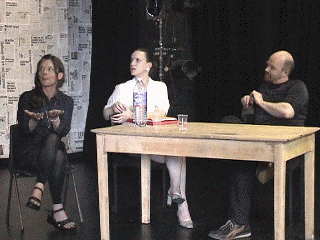
Susan: I suppose that when I mentioned Hamlet, it wasn't that you were going to stage a dramatic text; but nonetheless if we were to look at Hamlet as some kind of blueprint for an event, then it has a particular temporal potential, it is punctuated already in a particular way, it sets up particular groupings and potential for movement, and tradition says that it has a particular emotional potential in it. So it isn't that I'm suggesting that you are 'representing Hamlet', but I'm wondering if there isn't something abstract when you read Hamlet, or something abstracting, when you read Hamlet as a choreographer, which isn't a matter of looking for characterization as such, but looking for characterization as movement potential, which intersects with other movement potential for the groupings, into which you have cast particular, potentially virtuosic performers...
Renate: and then you add a particular generic framework in the music, which reinforces your intention...
Kim: It depends on what you mean by intention. If you mean an intention to express the story, then...
Renate: He doesn't want us to fix anything!
Susan: I would day that 'express' is a bad word here if we're interested in process. I would sooner say that you 'im-press' some elements abstracted from Hamlet onto your dancers - can Hamlet be a mode of im-press, rather than ex-press - I mean ex-press quite literally, as in 'press out'. Instead you press something - a number of 'somethings' - containing, and at the same time something/s demanding, into or onto the highly energized expert movement potential which your dancers bring?
Because I have watched you at work with them, late in the process - I've watched you working on fine tuning with them, and I've watched you press something into them, a spatial relationship around them and a set of spatial details, into them and around them and you are inflecting that in terms of the potential that each of them offers you, which you have observed...
Kim: Yes.
Susan: You are working very closely with them - if I say the principal dancers it's because of the burden of time they have in the piece - I can give you an example, which is Jo O'Keefe, playing Ophelia. I watched you impress something into Jo, in rehearsal, so that it's almost as though what she gives you comes from that complex in-press - by which I mean quite literally something pressed-in on her in an almost painterly manner, from your perspective, some feet away from her. I was very interested to note that in discursive terms you used no abstract terms, no adjectival or adverbial qualifiers, no interpretative language, nothing relating to intention, to 'what I want to get out of this scene'; no language relating to feeling, or showing, but only what [M.A.K.Halliday once called] material processes, nouns and verbs relating to the actual physicality of the work that you'd both already constructed through the dance/dancer/choreographer relationship. When Jo was working on this, something was pressing-in - in almost a painterly fashion, on the minute detail of her movement - that she was delighted with when she went back into rehearsal and used the change in detail which she had experienced physically in this one-to-one engagement.
An audience member: Can you give an idea of the actual language that Kim was using?
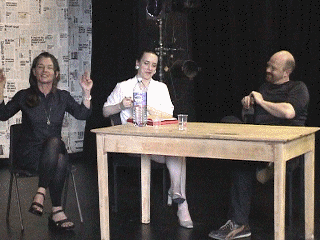
Susan: I don't have a dance-technical register... um, at a particular moment in her work she slides forward across the floor and Kim says "What happens if you reach further with your arm, and if you turn you hand like this?" "what happens if your wrist turns slightly?" Coming as I do from theatre-making, this was to me a remarkable reticence. He never once interpreted on her behalf, and never once did she comment on the change in terms of interpretation, but she 'interpreted' by saying, 'That feels right'. It was something finer, that Kim could see, and that I couldn't see - which was a relationship to the whole. But more generally the notion I was talking about this morning, that we are liable to sense things in performance decision-making, that we recognise things, that we recognise when there is some kind of empirical fit with the material, seems to me to apply here, for some of these decisions, but they apply differently to what Kim was doing and to what Jo was doing.
The audience member: I think that what happens in those moments is a crucial but wholly under-considered research matter.
Susan: Absolutely.
Kim: When you say this - I mean, I don't remember this precise moment - but what I feel that I was doing was to try to facilitate the movement that was already there, so if I say to her "shift your weight onto the side of your hand, it makes it easier to slide", or if I say "if you have your weight more on your back heel", or "if you press your hips through..." then it's always pursuit of the motion and the line.
Susan: But it wasn't 'just' pursuit of the line, it was pursuit of the line up to this pre-given point, then stop.
Renate: Susan means that you use a language that refers to the physical.
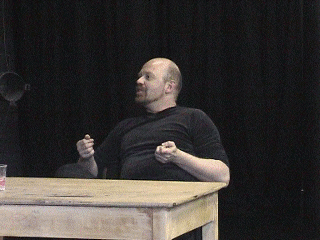
Susan: No, it refers to the mastery of the physical in disciplinary terms - we have to qualify the observation - there was that judgement of quality in it...
Renate: Yes, it was mastery of the physical, but the end achieved is a particular image.
Susan: I don't actually know what you mean by 'image' - I mean, I know what 'image' means in general, but what - does it have something to do with time? I suppose that 'image' is something relatively static? I don't know what 'image' means for you here, so you would have to qualify the term.
Renate: A particular moment or a particular dynamic in the movement, that you want to achieve, which you had in mind [as a choreographer] and that you want to reveal - and I think that you avoid using a language that refers to meaning, or content, or interpretation, or expression, but you are using a language that refers to physical mastery.
Kim: I want to keep coming back to the motion: you see it as an image, you say that we arrive at something, and you see the image as conveying character, you said that there was a figuration that the bodies took that expressed something to you...
Renate: But I thought that you would see an ideal image, and make a correction.
Kim: - the image... it's just there as a guiding point, and half of them go once the motion sets in - they are there to stop that, but what matters is how somebody gets there, even if it's tiny. It's not the shape that a body makes - I mean of course I know that the body makes a shape, while it's moving, but what I'm saying is that what I think, when I'm choreographing, is the motion.
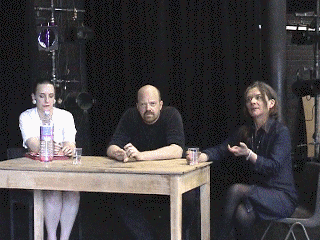
Susan: One of the difficulties that we have then, in terms of the discourse, is how do we write motion? We can describe images, we can look at compositions within frames discursively, but how do we write about motion, in its particularity, in a practitioner's work?
Kim: I decided with Jonathan that we would would look at something that happens at the beginning of making a piece - we have only had 20 minutes to work on this and it's important that you know this. What we do, at that particular beginning, is I set what I call 'rooms of time', and I say for example to Jonathan you've got a count of nine - I count through a duration, which is not exactly the same as a musical duration, but he knows that this 'room' will allow for this much motion. At this point, I leave him completely free, I don't give him anything else but the time as a structure, then I look for a piece of music. In this case, Jonathan has heard it only once - I'll do it once just counting - Jonathan...
Jonathan: Can I just say something about the earlier conversation? As a dancer, I wanted to say that there are times in rehearsal when we're just exploring movement for movement's sake - and it's not always possible to actually see what we're doing. Sometimes things get a bit clumsy, so it's important that Kim is our eyes, so what we're doing is - it's important to say with the physical detail you were talking about, intention comes much later. Anyone who's worked with Kim will tell you that it's impossible to get anything out of him about what he wants, what he intends. For the whole six weeks' rehearsal time, none of us knows what we're doing, or anything about 'our' character, all we're working with is the movement and where the movement is taking us. The 'intention' comes at a much later date, perhaps the night before the show opens...
Kim: What I want you to see now is the movement within the structure - Jonathan is completely free to move within the structure - I'll give you the nine counts. We'll start with ...
|
|
|
Kim Brandstrup studied film at the University of Copenhagen and choreography under Nina Fonaroff at the London Contemporary Dance School before establishing Arc Dance Company in 1985. Kim has created twenty works for Arc including Saints and Shadows (Olivier Award nominee), Antic (based on Hamlet), Crime Fictions, Peer Gynt, Garden of Joys and Sorrows and The Return of Don Juan, featuring Irek Mukhamedov. Kim's credits also include: Orfeo for London Contemporary Dance Theatre which won the 1989 Laurence Olivier Award for Most Outstanding Achievement In Dance, also performed by Arc Dance Company; Sacre Du Printemps (1991) for Geneva Ballet; Benjamin Britten's Death In Venice (1992) for the Royal Opera and the Metropolitan Opera, New York; White Nights for English National Ballet; Zemir Et Azor for the Drottingholm Opera House (1993); Othello, commissioned by Irek Mukhamedov which went on to win the London Evening Standard Award for Most Outstanding Production (1994); Mysterier for the Royal Danish Ballet, filmed by Danish Television; Eidolon for Rambert Dance Company; director of Peter Handke's play The Hour We Knew Nothing Of Each Other in Mälmo, Sweden; Cupid And Psyche for the Royal Danish Ballet (1997), Sleeping Beauty for the Royal New Zealand Ballet (1999), Place of Stone for the Norwegian National Ballet (2001) and The Queen of Spades for Les Grands Ballets Canadiens de Montréal (2001). Last year Kim created a new work, Elegy and revived Orfeo and Saints and Shadows for Arc's 2001 tour, The Art of Storytelling which was nominated for a Barclays Theatre Award for Outstanding Achievement in Dance. He was recently appointed AHRB Fellow in Creative and Performing Arts at Middlesex University.
Renate Bräuninger is a research assistant at Middlesex University and is currently writing a PhD on the relationship between music and movement, using George Balanchine's ballets choreographed to Peter Tchaikovsky's music as an example. Her background is in dance and music. She studied musicology at the Ludwig Maximilias Universität Munich and the Technische Universität Berlin. A scholarship of the DAAD (Germany Academic Exchange Service) allowed her to live in New York City where she studied dance theory and criticism with Marcia Siegel and choreography with Bessie Schönberg.
Susan Melrose is Professor in Performance Arts in the School of Arts, Middlesex University. She completed higher degree research in the performing arts in Paris in the early 1980s (with Patrice Pavis and Annie Ubersfeld) and has established/taught postgraduate studies at the Université de Tunis, Brunel University, Central School of Speech and Drama and Rose Bruford College. Her published work focuses on the urgent need for the systematic reappraisal of "critical orthodoxies" in Performance Studies, not least when arts-professionals bring their art-practices as research into the higher degree context.
Jonathan Poole trained at Derby Academy and Northern School of Contemporary Dance, graduating in 1996 with a Bachelor of Performance Arts. He joined Arc Dance Company in 1996 as an understudy and returned to perform in Orfeo (1997) and has become a regular member of the company performing in every production since 1999. Jonathan has worked with Akram Khan, Melanie Clarke and New Balance Dance Company. Other work includes performances with the Royal Opera, English National Opera, Garsington Opera and Welsh National Opera.
Web design and rolling gifs copyright © John Robinson 2003.
Video images by Hannah Bruce and John Robinson.
Last updated, 15th August 2004, 11:35.

